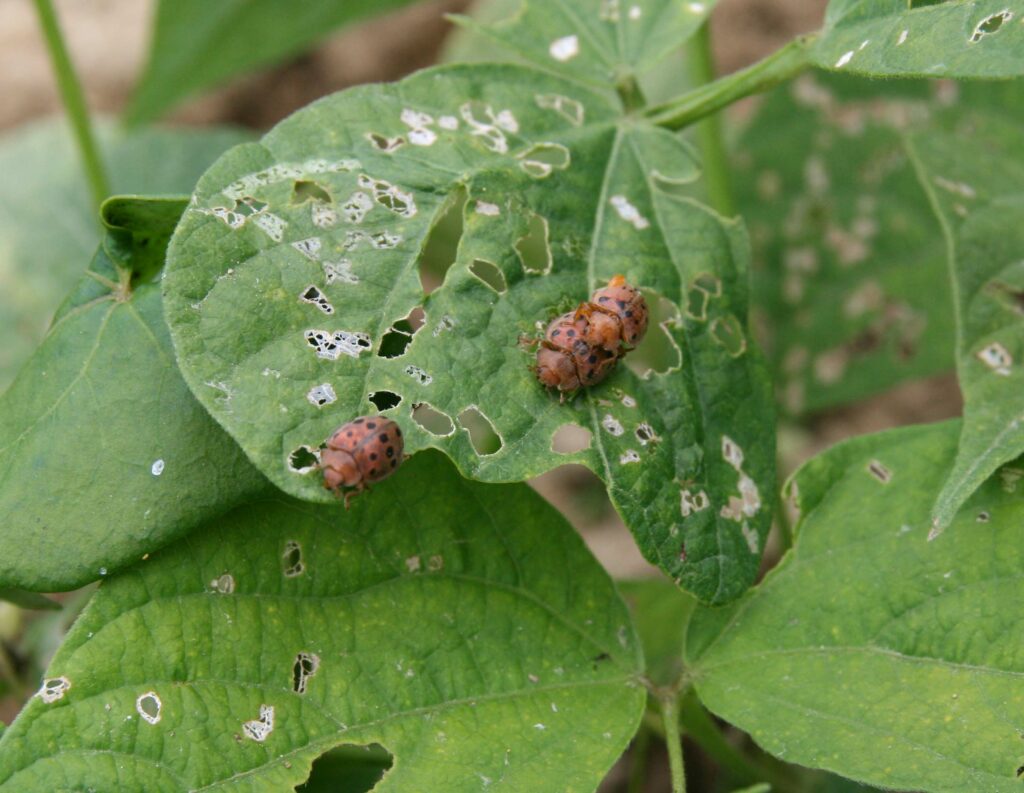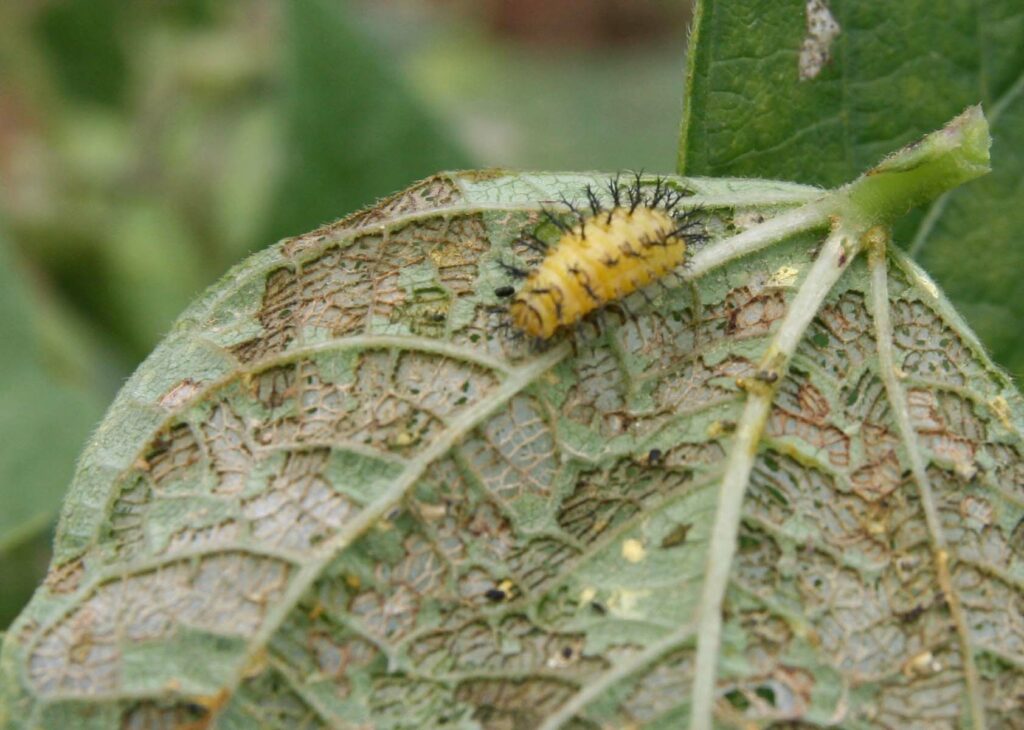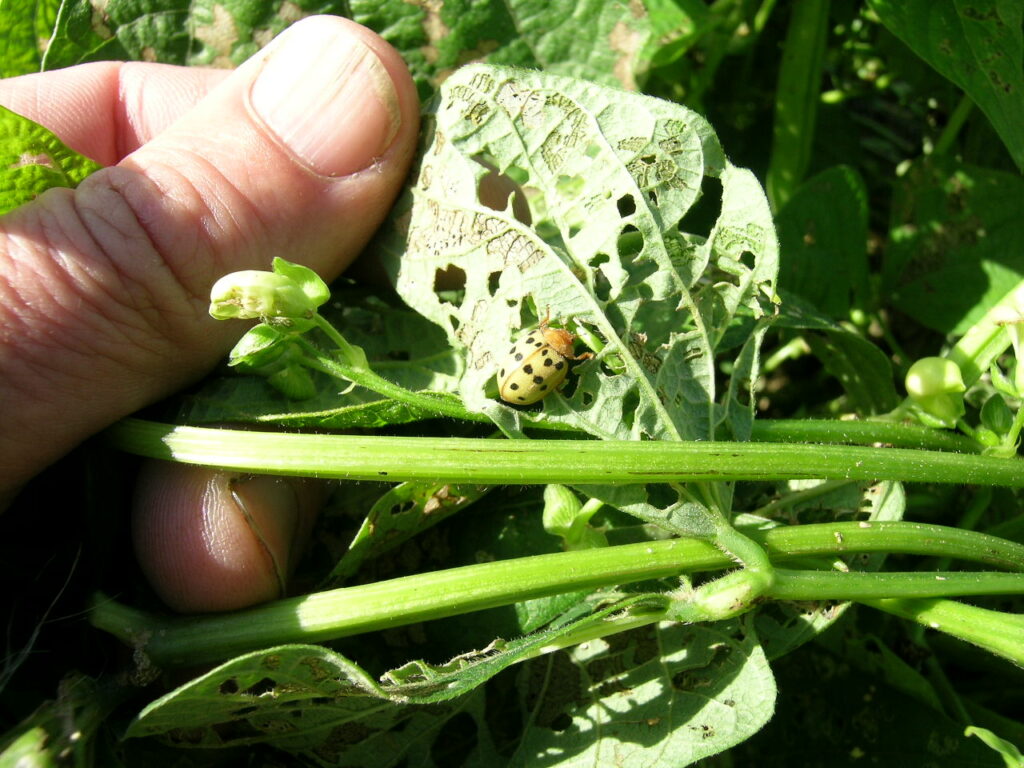
Pest: Mexican bean beetle (Epilachna varivestis)
Pest/disease identification and lifecycle, most common damage symptoms and crops affected:
If Mexican bean beetles have historically been a problem on your farm or in your garden, you will very likely see them again this year. They may be pests on snap beans, dry beans, soybeans and lima beans. While they are not a pest on every farm, some farms report repeated significant damage from these pests and have to take action to prevent crop loss if populations have built up to damaging levels. Using biological control can reduce, or supplant, the need for insecticides.

Mexican bean beetle adults are coppery brown with black spots. They look very much like large ladybeetles and are in fact closely related — but unlike lady beetles they feed on leaves, not other insects. Adults lay yellow-orange egg masses on the underside of bean leaves. These hatch into bright yellow, spiny oval larvae, which feed, molt several times as they grow, and pupate on the underside of leaves. Feeding damage from adults and larvae can reduce yield and injure bean pods if numbers are high. There are several generations per season, often with increasing populations in each generation.

Management options:
Biocontrol options:
Pediobius foveolatus is a commercially available biological control agent for Mexican bean beetle control and has a good track record in the mid-Atlantic states and among New England growers who have tried it. (Pediobius is pronounced “pee-dee-OH-bee-us.”) It is mass-reared and sold by the New Jersey Department of Agriculture and is also available from other beneficial insect suppliers. This small (1-3 millimeter), non-stinging parasitic wasp lays its eggs in Mexican bean beetle larvae. Wasp larvae feed inside the bean beetle larva, kill it, and pupate inside it, forming a brownish case or “mummy.” About 25 adult wasps emerge from one mummy. Control continues and in fact gets better as the season progresses and successive generations of the wasp emerge and search out new bean beetle larvae.

Planning two to three releases at 7-10 day intervals will help ensure good timing. and coverage on several plantings. This makes biocontrol well suited to our succession-planted snap bean crops. After a release in the first plants, it is advisable to leave that planting intact for a while, until the next generation of wasps has emerged from their mummies. As with any biological control, make releases as soon as the pest is present — not after it has built up to damaging numbers. The New Jersey Department of Agriculture Beneficial Insect Rearing Laboratory recommends two releases, two weeks in a row, coinciding with the beginning of Mexican bean beetle egg hatch. Wasps will lay their eggs in larvae of any size, but it is best to target newly-hatched young larvae. This will give control before damage has been done. Thus, timing is important. Watch for eggs and time the shipment for the first hatch of eggs into larvae. If in doubt about the timing of the hatch, release as soon as you see the eggs — if you wait for the larvae you may be playing catch-up. The release rate should be at least 2,000 adult wasps per field for less than an acre, or 3,000 per acre for fields of one acre or more.
Pediobius wasps are shipped as adults or “mummies” (pupae inside dead larvae) from which adults will emerge. Order adults if you already have Mexican bean beetle larvae in the field. Ship for overnight delivery. Instructions for handling and release will come with the wasps. Wasps reproduce in the field and will still be around when the second generation of bean beetles hatch. Thus, it should not be necessary to make more than two releases. Like beans, Pediobius wasps are killed by frost.
Plan ahead by contacting a supplier to inform them of your expected release dates and acreage. Contact information for the New Jersey source is: Wayne Hudson, 609-203-9782, [email protected], NJDA, Phillip Alampi Insect Lab, West Trenton, New Jersey 08628. https://nj.gov/agriculture/divisions/pi/prog/beneficialinsect.html. You’ll also get advice on how to use the wasps from this office.
Pediobius is also available from:
ARBICO organics, Arizona, 800-827-2847. Order online; orders ship on Wednesdays only, minimum seven day processing.
IPM Labs, New York, 315-497-2063. Contact to check availability.
Beneficial Insectary Inc., California, 800-477-3715.
Pesticides approved for use in certified organic production (as a last resort):
Moderate control can be achieved with spinosad (Entrust SC for commercial use, or Monterey Garden Insect Spray, Natural Guard Spinosad or Bonide Captain Jack’s Deadbug Brew for residential use). Mixtures of pyrethrin and azadirachtin (Azera, for example, or a tank mix of PyGanic EC 5.0 and Neemix) can also be used for commercial applications. (For home gardens, there is Azera Gardening, or standalone pyrethrin and azadirachtin products can be mixed, like PyGanic Gardening and Bonide Neem Oil, for example.)
Please note: This information is for educational purposes. Any reference to commercial products, trade or brand names is for information only, and no endorsement or approval is intended. Pesticide registration status, approval for use in organic production and other aspects of labeling may change after the date of this writing. It is always best practice to check on a pesticide’s registration status with your state’s board of pesticide control, and for certified organic commercial producers to update their certification specialist if they are planning to use a material that is not already listed on their organic system plan. The use of any pesticide material, even those approved for use in organic production, carries risk — be sure to read and follow all label instructions. The label is the law. Pesticides labeled for home garden use are often not allowed for use in commercial production unless stated as such on the label.
Source material attribution: Reprinted and modified by Eric Sideman and Caleb Goossen, from the University of Massachusetts Vegetable Notes Newsletter written by Ruth Hazzard and A. Brown.

